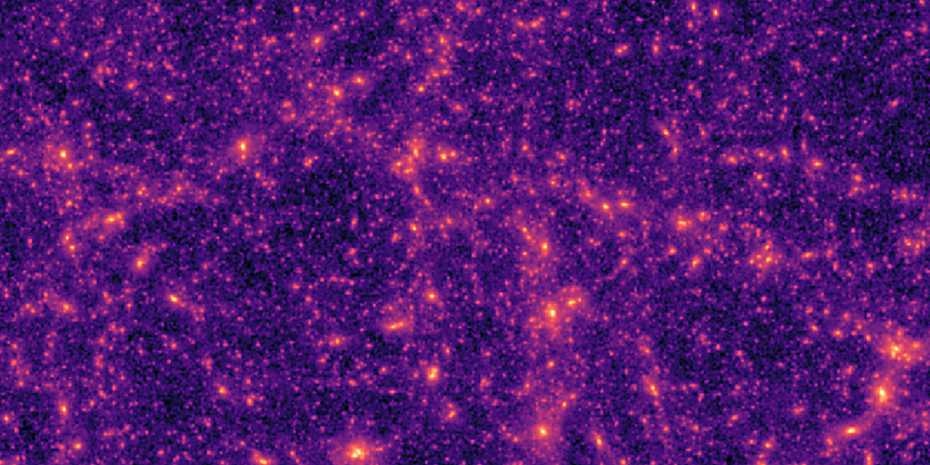Sep 19 2019
A group of computer scientists and physicists at ETH Zurich has created a new method to solve the puzzle of dark energy and dark matter in the universe.
 Excerpt from a typical computer-generated dark matter map used by the researchers to train the neural network. (Image credit: ETH Zurich)
Excerpt from a typical computer-generated dark matter map used by the researchers to train the neural network. (Image credit: ETH Zurich)
With the help of machine learning tools, the team programmed computers in such a way that these systems can obtain the relevant data from the maps of the universe.
One of the biggest challenges faced in science is the understanding of the universe—for instance, how it evolved to be what it is today and what will be its ultimate destiny. Although the remarkable display of an unlimited number of stars on a clear night provides some idea about the extent of the problem, it is just a part of the story. The more serious mystery lies in what humans cannot visualize, at least indirectly; dark energy and dark matter come under this ambit.
With dark energy causing the universe to expand faster and dark matter pulling it together, cosmologists must know precisely how much of the dark matter and dark energy are there in the universe in order to tune their models.
Researchers from the Department of Physics and the Department of Computer Science at ETH Zurich have now teamed up to enhance the standard techniques. Their aim is to use artificial intelligence to measure the dark matter content of the universe.
The researchers used sophisticated machine learning algorithms for cosmological data analysis. The algorithms have a lot in common with those utilized for facial recognition by various social media, including Facebook. The team’s results have been recently reported in the scientific journal Physical Review D.
Facial Recognition for Cosmology
Although pictures taken of the night do not contain any recognizable faces, cosmologists still search for something quite similar, as Tomasz Kacprzak, a scientist in the group of Alexandre Refregier at the Institute of Particle Physics and Astrophysics, explained: “Facebook uses its algorithms to find eyes, mouths or ears in images; we use ours to look for the tell-tale signs of dark matter and dark energy.”
Since dark matter cannot be directly visualized in telescope images, physicists generally depend on the fact that the dark matter and all other variety somewhat bend the path of light rays reaching the Earth from remote galaxies. This effect is referred to as “weak gravitational lensing.” It blurs the images of those distant quite slightly, just like far-away objects seem distorted on a hot day as light travels through atmospheric layers at different temperatures.
That distortion can be used by cosmologists to work backward and produce large maps of the sky, demonstrating the location of dark matter. Those dark matter maps can then be compared with hypothetical predictions to identify which cosmological model corresponds with the data most closely.
Conventionally, human-designed statistics like the so-called correlation functions are used to do this. These correlation functions describe how different portions of the maps are related to one another. However, such statistics are restricted as to how well they can trace intricate patterns in dark matter maps.
Neural Networks Teach Themselves
In our recent work, we have used a completely new methodology. Instead of inventing the appropriate statistical analysis ourselves, we let computers do the job.
Alexandre Refregier, Institute of Particle Physics and Astrophysics, ETH Zurich
This is where Aurelien Lucchi and his coworkers from the Data Analytics Lab at the Department of Computer Science enter. Along with Janis Fluri, a PhD student in Refregier’s team and study lead author, the team utilized machine-learning algorithms known as deep artificial neural networks and taught them how to extract as much data as possible from the maps of dark matter.
Initially, the researchers trained the deep artificial neural networks by feeding them with computer-generated data that replicates the universe. That way, the researchers knew what should be the right answer for a specified cosmological parameter—for example, the ratio between the total amount of dark energy and dark matter—for each simulated map of dark matter.
After repeated analysis of the dark matter maps, the neural network learned itself to search for the precise kind of features in them and to obtain an increasing amount of the required data. In the Facebook analogy, the neural network got better at differentiating haphazard oval shapes from mouths or eyes.
More Accurate than Human-Made Analysis
The outcomes of that training were promising: the neural networks provided values with an accuracy of 30% more than that acquired through conventional techniques based on manmade statistical analysis. That is a huge enhancement for cosmologists because achieving the same precision by raising the number of telescope images would need twice as much observation time, which is quite costly.
Ultimately, the researchers utilized their completely trained neural network to examine real maps of dark matter from the KiDS-450 dataset.
This is the first time such machine learning tools have been used in this context, and we found that the deep artificial neural network enables us to extract more information from the data than previous approaches. We believe that this usage of machine learning in cosmology will have many future applications.
Janis Fluri, Study Lead Author and PhD Student, Institute of Particle Physics and Astrophysics, ETH Zurich
As a next step, Fluri and his coworkers are intending to apply their technique to larger image sets like the Dark Energy Survey. In addition, more cosmological parameters as well as refinements like details related to the nature of dark energy will be fed to the deep artificial neural networks.